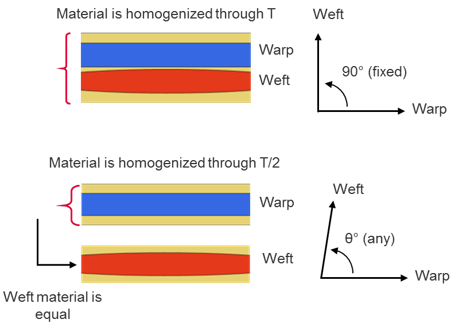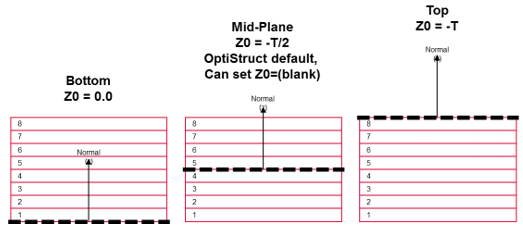Composite Definition
Composite shell model definition.
- Ply-based model. Refer to Ply-Based Shell Modeling for further details.
- Zone-based model. Refer to Zone-Based Modeling for further details.
Ply-Based Models
Ply-based modeling entities.
Plies
- Manually from the Composite Browser
- Conversion from zone-based models using the Aerospace Composite Absorb Tool
- Imported from a spreadsheet
- Imported from external composite data like CATIA or FiberSim.
For more information, refer to Plies.
Uni-Directional
Uni-directional plies should be modeled layer by layer using ply entities. The material assigned represents properties homogenized at the ply level.
Woven
| Homogenization Scale | Comment |
|---|---|
| Homogenization of matrix, tows in warp and weft directions | Impractical to drape - any deviation from θ=90° is new
anisotropic material. Cannot distinguish between ply level fiber and matrix direction results. |
| Homogenization of matrix and tows in just one direction | Weave modeled as two uni plies with ½ T. Same material when θ changes. HyperMesh uses this methodology when importing woven plies from external composite data. |

Figure 1.
Laminates
One ply laminate or interface laminate per physical part is typically defined. Ply laminates are used for composite panels and plates without T junctions or other complex geometry. Interface laminates are used in conjunction with sub-laminates to model complex parts, typically with T junctions. For example, an I-beam.
For more information, refer to Laminate Entities.
Ply-Based Properties
Properties for ply-based models are used as templates. The attributes of the property, offset, non-structural mass, and so on, assigned to component(s)/element(s) are used when final zone-based properties are generated by HyperMesh. If the solver is OptiStruct or Radioss, this definition is formalized – PLY and STACK (Laminate) cards define the layers at each zone and the property defines the additional solver-specific attributes.
- OptiStruct and Radioss require ply-based properties to be assigned. This contains typical solver-specific property information like offset, but composite layers are managed by plies and laminates.
- Other solvers require a standard zone-based composite property to be assigned to elements contained in the plies of a laminate. Any specific solver attributes should be set in this property. Typical zone-based layers data does not need to be entered as it is maintained by the ply-based model. Upon realization of the laminate, zone-based solver properties will be automatically generated.
| Solver | Property |
|---|---|
| OptiStruct | PCOMPP (ply-based cards are part of the solver – zones do not need to be generated) |
| Radioss | PCOMPP (ply-based cards are part of the solver – zones do not need to be generated) |
| Nastran | PCOMPP (Option to realize to PCOMPG/PCOMP) |
| Abaqus | *SHELL SECTION (COMPOSITE) |
| ANSYS | SECTYPE SHELL |
| LS-DYNA | *PART COMPOSITE (on HyperMesh Component entity) |
Zone-Based Models
Zone-based modeling entities.
In addition to generation from the realization of a ply-based model, zone-based models can be created manually. Instead of specifying ply, laminate and template property entities, zone-based solver properties should be defined for each zone of constant thickness.
Offsets
Offsets determine the location of the laminate relative to the mesh.

Figure 2.